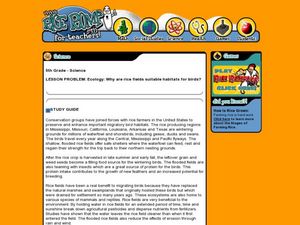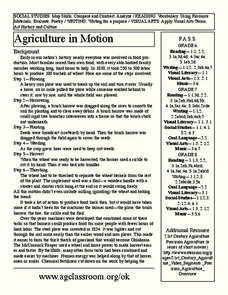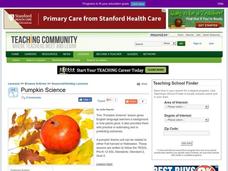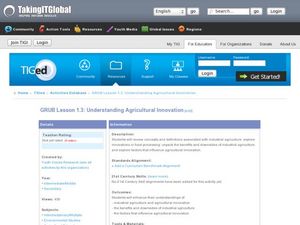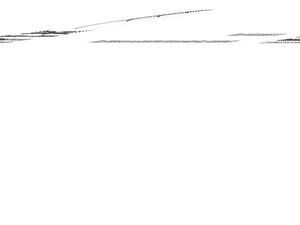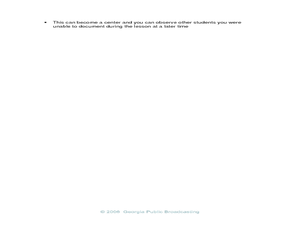Curated OER
Rice Nutrition
Third graders investigate nutrition by researching rice. In this food instructional activity, 3rd graders read about the healthy aspects of rice and how many people in the world eat it. Students read nutrition labels and...
Curated OER
Cultivating Oklahoma's Future
In this Oklahoma agriculture lesson, 8th graders read and discuss information and vocabulary about new developments in agriculture. Students write essays on the future of agriculture in Oklahoma.
Curated OER
Ecology: Why Are Rice Fields Suitable Habitats for Birds?
Fifth graders discover the uses for rice by reading about the habitats of certain birds. For this agriculture lesson, 5th graders research birds from the Gulf Coast and California and their reasons for living in rice fields....
Curated OER
What Happens to Rice at the Mill
First graders investigate rice farming by creating an art project. In this agriculture lesson, 1st graders read about the path rice takes from a mill to your plate. Students utilize a piece of paper to create a...
Curated OER
Ag in my classroom
Students fill out worksheets and create a poster based on items in their classroom that came from agriculture. In this agriculture lesson plan, students discuss different classroom items and how they were or were not made from agriculture.
Curated OER
Agriculture in Motion
Sixth graders write a poem and an essay about the machines they have learned about that are used in agriculture. In this machines lesson plan, 6th graders compare different kinds of machines and discuss the economic impact machines in...
Curated OER
Botany: Irrigating of Rice
Fourth graders discover agriculture by researching the irrigation of rice. In this farming lesson, 4th graders read about the different methods of rice farming and create an illustration for each different action. Students...
Curated OER
How Many Types of Rice Are There?
Sixth graders investigate the cultivation and variation of rice around the world. In this food lesson, 6th graders read about the process of bringing rice from a farm to your dinner plate and which types of rice grow in which...
Curated OER
Pumpkin Science
Young scholars investigate how plants grow by analyzing pumpkins. In this agricultural lesson, students read The Biggest Pumpkin Ever by Steven Kroll, and draw pictures of a pumpkin in each of its growing stages. Young scholars measure...
Curated OER
What to do with Malus-domestica, Cultivated Apples?
Students take on the roles of apple farmers. In this Arizona agriculture lesson, students explore the concepts of supply and demand as they role play apple farmers who create marketing campaigns when supply outweighs demand.
Curated OER
If It Smells Good, Is Edible, and Attracts Wildlife, Then It's a Practical Garden
Students explore landscape design. In this practical gardening lesson, students design landscape plans that call for shrubs, trees, and plants that can be used for aesthetics, cooking, and wildlife.
Curated OER
The Cox and Gossner Family Histories
Eleventh graders investigate the relationship between physical geography and Utah's settlement , land use, and economy. In this Geography lesson plan, 11th graders examine the interrelationship between Utah's climate. ...
Curated OER
Understanding Agricultural Innovation
Students explore agricultural innovations. In this agriculture lesson plan, students investigate innovations in industrial agriculture and write about the positive and negative impacts of the innovations.
Curated OER
Field Crops in the Food System
Students complete activities related to food production and distribution. For this agriculture lesson, students read and discuss the crops grown in Iowa and Wisconsin and the ways the crops are used. They complete activities related to...
Curated OER
Where in the World is Utah Wheat?
Students examine the role of climate and landforms in the use of Utah's land. In this geography lesson, students analyze the relationship between geography and agriculture in the state as they examine data regarding wheat production in...
Curated OER
Era of Self-Sufficiency - Pre-1890
Students investigate the relationship between physical geography and Utah's settlement. In this Utah land instructional activity, students view a PowerPoint about Utah land and work in groups to answer questions about the uniqueness of...
Curated OER
Google Earth on the Range
Eighth graders use Google Earth to study the landscape of Utah. In this Utah landscape lesson, 8th graders view landscape photos and work in partners to analyze the pictures. Students write a paragraph that describes the landscape and...
Curated OER
A Common Thread: The Significance of Wool In Midieval England
Sixth graders fill in a KWL chart and participate in a simulation of role playing about the Renaissance. In this Renaissance lesson plan, 6th graders learn how agriculture affected the culture of Midieval England.
Curated OER
Sorting Gourds
Students discover different types of gourds. In this plant comparison lesson, students compare and contrast several types of gourds based on shape, color and texture. Students observe a video clip based on sorting gourds.
Curated OER
What is Biotechnology
Young scholars discover the concept of biotechnology. For this biotechnology lesson, students explore the history of biotechnology and its implications today.
Curated OER
Clothesline Sleuth
Students explore the make up of fabrics. In this agriculture lesson, students examine the cotton and wool crops of the United States and discover how fabrics are created.
Curated OER
Agriculture and Me
Second graders categorize and organize agricultural products. In this agriculture activity, 2nd graders complete classroom activities that challenge them to make connections between agricultural products and their own lives.
Curated OER
Defining Agriculture and Natural Resources
Students define agricultural using concept maps. For this agriculture lesson, students use concept maps to determine the ideas that are related to agriculture such as farming, food, flowers, and forestry before defining the word...
Curated OER
Where Does It Come From?
Learners examine food sources. In this agriculture activity, students investigate how food is stored, moved, and processed as they participate in a classroom activity.


